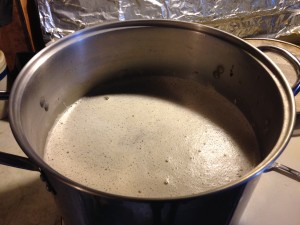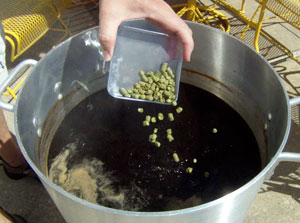The first installment of this article discussed the idea behind a brut IPA, the grist, and the mash. The second installment discussed the enzyme used to make a highly — to completely — fermentable wort. This installment will discuss the boil and packaging.
 Once the wort is in the kettle, and the enzyme treatment is over, the brewer should proceed to the boil. Brut IPA is supposed to have a lot of hop aroma, but not as much hop bitterness as a normal IPA. How much bitterness is, of course, up to you. The main things to consider when choosing a level of bitterness are the OG and FG of the beer, and — of course — your personal preference.
Once the wort is in the kettle, and the enzyme treatment is over, the brewer should proceed to the boil. Brut IPA is supposed to have a lot of hop aroma, but not as much hop bitterness as a normal IPA. How much bitterness is, of course, up to you. The main things to consider when choosing a level of bitterness are the OG and FG of the beer, and — of course — your personal preference.
BU:GU Ratio and Relative Bitterness Ratio
In his book “Designing Great Beers,” Ray Daniels discusses the BU:GU ratio — the level of bitterness (in IBUs) divided by the original gravity (in “gravity points”). The website of the Mad Alchemist (Ryan Shwayder) takes the concept one step forward and incorporates attenuation into the formula, which he gives as:
RBR = (BU:GU) x (1 + (ADF – 0.7655))
where RBR is the relative bitterness ratio
BU is bitterness (in IBUs)
GU is the OG (in “gravity points”) and
ADF is the apparent degree of fermentation, expressed as a decimal (for example, 75% apparent attenuation is 0.75)
The number 0.7655 is a fudge factor, based on the average ADF of beer styles listed in the 2008 BJCP guidelines. The formula will thus return a number that gives the relative bitterness of the beer, compared to an average of 0.5. If your RBR is over 0.5, your beer is more bitter than average. As you can see, the higher the ADF, the larger the number the BU:GU ratio is multiplied by. This is because the drier the beer is, the more pronounced the bitterness will be. In the 2008 BJCP Guidelines, the RBR for American IPAs was 0.848. English IPAs rated a 0.800 and American pale ales clocked in at 0.705 — all over 0.500 (the average of all styles).
 When choosing your level of IBUs, running the numbers through the RBR formula will help give you an idea of the relative bitterness of your beer. However, be aware that other things also influence how the bitterness in a beer is perceived, especially the level of sulfate.
When choosing your level of IBUs, running the numbers through the RBR formula will help give you an idea of the relative bitterness of your beer. However, be aware that other things also influence how the bitterness in a beer is perceived, especially the level of sulfate.
The original idea of brut IPA was to have the beer be less bitter than an IPA. So, aim for less than 0.8 — and perhaps even less than 0.7. But, you can set the level of bitterness to your liking. (And if you think the beer shouldn’t be called an IPA if it’s bitterness is low, call it a brut PA instead. There are no rules here.)
Finally, you need to decide on the amount of late hops and dry hops. For a 5.0-gallon (19-L) batch, one ounce (28 g) of hops at knockout and an ounce (28 g) of dry hops would give a level of hop aroma similar to an American pale ale. Bumping that up to 1.5 ounces (35 g) for both additions would put you in the range of an American IPA. Another notch up — to 2.0 ounces (57 g) late hops and 2.0 ounces (57) dry hops — would land you in the lower range for a double IPA. Whirlpool hopping, or a hop stand, is another option for the beer.
In the next installment of this article, I’ll discuss yeast strains and fermentation.
If you enjoy Beer & Wine Journal, please consider supporting us by purchasing one of my books, which include “Home Brew Recipe Bible,” by Chris Colby (2016, Page Street Publishing) and “Methods of Modern Homebrewing,” by Chris Colby (2017, Page Street Publishing). Both are available online though Amazon (linked) and Barnes and Noble. You can also find the nearest independent bookseller that carries them through Indiebound. You can also support this website through the donation button. Thank you.

[…] Brut IPA (III: Boiling and Bitterness) […]